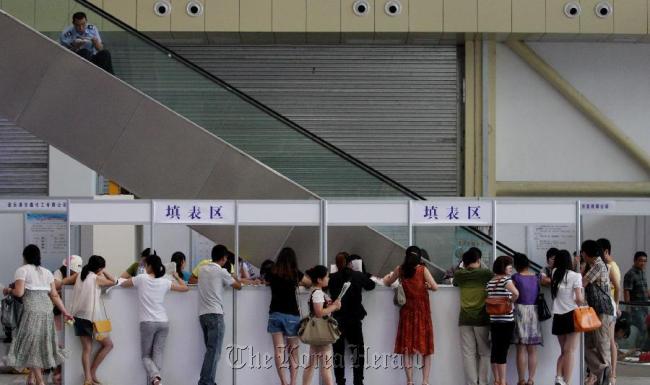When public relations manager Helen Chen quit her job to take a short break, she was confident of landing another in a matter of days once she was ready to rejoin the workforce.
That was in June, when the Chinese economy was expected to bottom out and make a recovery.
Now, three months later, Chen, 30, has yet to find a new position, despite having had interviews with four Beijing companies in the car, engineering, accounting and luxury goods sectors.
“While companies still advertise positions, I get the sense that they are not keen to hire immediately. They want to wait a few months and see,” she said.
The labor market is the latest segment of the economy to feel the strain of a slowdown that has been deeper and lasted longer than most analysts expected.
 |
Job seekers write application forms during a job fair in Lianyungang, east China’s Jiangsu Province. (Xinhua-Yonhap News) |
Private companies, which employ about 70 percent of the workforce, have been hit hard.
Cash-strapped firms across a range of industries are delaying investments, missing debt payments, or rolling over bank loans.
Now, in addition to delaying new hires, some have started laying off staff.
Insurance and property group Taikang became the latest to axe several hundred workers to “improve its organizational structure” last Tuesday, reported economics magazine Caijing.
Machinery giant Sany has cut over 12,700 staff members in the first half of this year, and Heilongjiang Coal-Mining Group is starting to reduce its workforce by 12,000, according to Internet portal Sohu.
Supermarket chain Tesco could lay off several hundred, it added.
Foreign firms such as Motorola Mobility, Adidas and U.S. Home Depot have announced layoffs in recent months as they close certain operations. But analysts say this may have more to do with strategy in the more challenging Chinese market than the slowdown.
Last month, an official employment index for large manufacturers came in at 49.1, indicating net firing. A figure above 50 indicates net hiring.
Similarly, a survey by staffing firm Manpower Group revealed last week that a small but growing proportion ― 4 percent ― of 4,000 Chinese businesses polled say they plan to reduce headcount.
Still, 63 percent said they planned to maintain or increase their workforces in the final quarter of this year, when the slowdown will hopefully bottom out.
While a growing number of analysts have downgraded their forecasts, the consensus so far appears to be that China will not fall below the 7.5 percent official target growth rate this year. This level ― rather than the traditional rule of thumb of 8 percent ― is adequate to create enough new jobs and avoid social unrest.
“This year, there is a recognition among policymakers that ... the benchmark has shifted, probably to between 7 percent and 7.5 percent,” said Royal Bank of Scotland economist Louis Kuijs, noting that the number of new workers entering the labor market today is one-third of that 10 years ago.
While there are no updated statistics on China’s unemployment rate, Vice Minister of Human Resources and Social Security Xin Changxing said the situation has remained “generally stable”.
Manufacturing jobs fell by 1.35 percent in July from a year earlier, but high-tech sectors saw a 4.6 percent increase, he told a press conference last week.
But the concern is whether job losses and credit problems will creep up if a recovery is delayed. Morgan Stanley analysts warned on Wednesday that “a modest growth rebound” could be postponed to “early next year.”
Dr. Kuijs, a former World Bank economist in Beijing, expects growth in the fourth quarter to slow to 6.9 percent.
“If things were to worsen much more than we expect in the remaining part of this year, it would likely pose greater risks for next year’s economic outcome rather than this year’s,” he said.
Already, Tsinghua University professor Patrick Chovanec is seeing annual gross domestic product growth fall closer to between 4 percent and 5 percent, as business and financial risks mount.
“I believe that private sector investment growth ― which official statistics put in the double digits ― may be overstated,” he said.
“More companies are facing a situation where their buyers aren’t able to pay for their goods, and are forced to sell on credit to keep the business afloat. So they are slashing investments.”
And cash-strapped companies in sectors such as heavy equipment, steel and property are reportedly extending their bank loans to stave off bankruptcy.
State-owned China Construction Bank said last month that it rolled over nearly 8 billion yuan of loans in the first half of this year, up about 10 percent from a year ago.
More recently, property firm Greentown indicated that it may roll over $1.8 billion in loans, while solar panel maker Suntech Power may extend the bulk of its $1.6 billion debt.
Smaller firms, which depend more on small lenders or the shadow banking sector for high interest-rate loans, may be at higher risk of default as their sales plummet amid shrinking demand at home and abroad.
Employers like Qiu Xiaoge, 23, who works in a Beijing book trading firm, is worried that layoffs will be her employer’s next cost-cutting measure.
“My boss has docked our pay until he can settle financing problems. More than half the sales team has been let go,” said the administrative assistant.
“Maybe I’m next.”
By Grace Ng
(The Straits Times)








